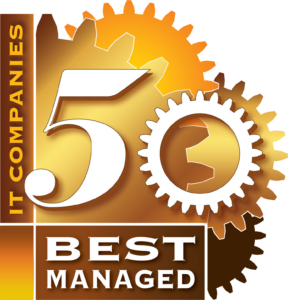IT Strategy: Four Critical Questions To Ask When Signing With A New MSP
IT Strategy: Four Critical Questions To Ask When Signing With A New MSP
IT Strategy
IT Strategy is key to keeping your business functioning. Hi, I’m Colin Shantz, CEO of CopperTree Solutions. And today I’m going to be talking about four critical questions to ask before signing with a new MSP.
The first one is what metrics do you track to determine success? And what we mean by that is, you know what exactly are they measuring and how do they, how do they quantify success? And we’ll, we’ll get into some, some details of how we do that later. The second question is how will you develop an IT strategy for our organization? So, what’s the process of understanding and recommending things that will allow your business to achieve success? Third question, what is your process for improving our IT infrastructure? So how do we get better over time and keep things working in that, in that optimal state? Fourth question, how do you identify recurring issues and improve on them? So, if there are ongoing problems, what’s the process for identifying them and placing a permanent solutions in place?
What Metrics Do You Track To Determine Success With MSP?
What we’re looking for is what are the key performance indicators. Or, in other words, what are the numbers that you’re looking at to determine success. In our organization there’s a bunch of things we look at. But, the biggest number that our clients look at is what we call our IT health score. So, there’s a, there’s a score that represents the health of the infrastructure. How does your organization align to best practices? And so you’re, you know 99% aligned with best practice or 92% aligned with best practice. It’s a high-level metric that allows the executive level to know if its something to worry about or is it good? And I can move on to other things. So that’s, that’s one of the things we look at.
Other IT Strategy Metrics
Another critical metric is the number of issues that you have in your organization. So, how many support tickets are there compared to the devices supported? And, looking at that one metric alone allows us to understand where things are. There’s standard numbers with a range that we like to see organizations within. And, if you’re outside of that range, then we know there’s a infrastructure or software problems. But it’s looking at how many, how many support tickets are you getting? And you want to get that as close to zero as possible. But, that’s the driving goal.
How Will You Develop An IT Strategy For Our Organization?
So, the IT strategy focuses on both infrastructure and also the big picture. How are we leveraging technology? So what’s the process to make sure that the IT is serving your organization’s needs? Our organization starts with what we call our quarterly vCIO meetings. It’s a quarterly meeting with a CopperTree individual who handles IT success. We start by understanding:
- your business,
- goals,
- problems,
- where are we today?
- where are we going in the future?
- how are we going to get there?
So we need to, we need to look at both the business and also the technology. Once we understand your business we’ll look at the infrastructure and technology. Next, we’ll say, are there other tools or technology we could be leveraging. Are other things we could be utilizing within your organization? Things that could improve communication or access to data. If you get better data you can make better decisions. How do we leverage technology to help you get to where you’re going? And it’s a constant conversation. Understanding what your challenges and goals are, and then making technology or recommendations.
What Is Your Process for Improving Our IT Infrastructure?
So infrastructures are always evolving. Generally, you never get to the place where everything is perfect. As soon as you do, there’s some new version that comes along. Or, there’s a new piece of technology that comes along, or something changes on the security side of things. So how do you always make sure that things are in that optimal state? How do you make sure that it’s meeting your business needs? So to do this, we have a technician that comes on site and goes through your infrastructure on a monthly basis. They as “how do you align with best practices?” And we have best practices for every piece of technology that our clients use. Everybody has very similar types of technology in place. Everyone has email, Wi-Fi, and files. They all have applications they use. And we have best practices associated with each of those technologies.
Then we go through and say alright, how do you stack up? And from that we get a health score. It could say you’re 99% aligned with best practice or you’re 95% aligned with best practice. And it’s designed to give the executives a way to measure the health. But, it’s also a way for us to say, “where are opportunities for improvement?” And once we’ve identified those areas we can, we can make some changes.
How Do You Identify Recurring Issues Within Infrastructure And Improve Them?
When we do analytics on issues that our clients are having, there are two types of things that we’re looking for. There are the issues that keep coming back. Things like:
why are we always having problems with a specific printer?
Why was there seven people that had a problem with remote access in the last month?
And then there’s also the the impactful type of issue. So, when it happened once but it had a major impact on the organization. As we look at each of our clients every month, we’re looking for areas where we can make some improvements. How do we change something today to prevent these issues from ever coming back?
Root Cause Analysis
And it starts with doing what we call a root cause analysis on the issues. So we’ll go back through and we’ll look at all the problems that happened in the previous month. Then we’ll say what can we do today to prevent these issues from coming back? And it could be a, it could be a technology change. There could be a problem with some hardware and it needs replacing. It could be a configuration issue where we go in and we change how something is set up and configured. We could need to put together a document for a user in training showing a particular task with seven steps. And when you do that then everything will just work. So we’re looking for those areas of opportunity.
And it, it sounds simplistic. It’s not rocket science, but it’s going back and looking at those issues and improving outcomes. If there’s a printer that always has problems, let’s replace it with something that just works. So as you make those little improvements, you can make a lot of progress over the course of months and years.
Thanks for joining me today as we talked about four critical questions to ask before signing with a new MSP. To learn more please visit our website at coppertreesolutions.ca.




